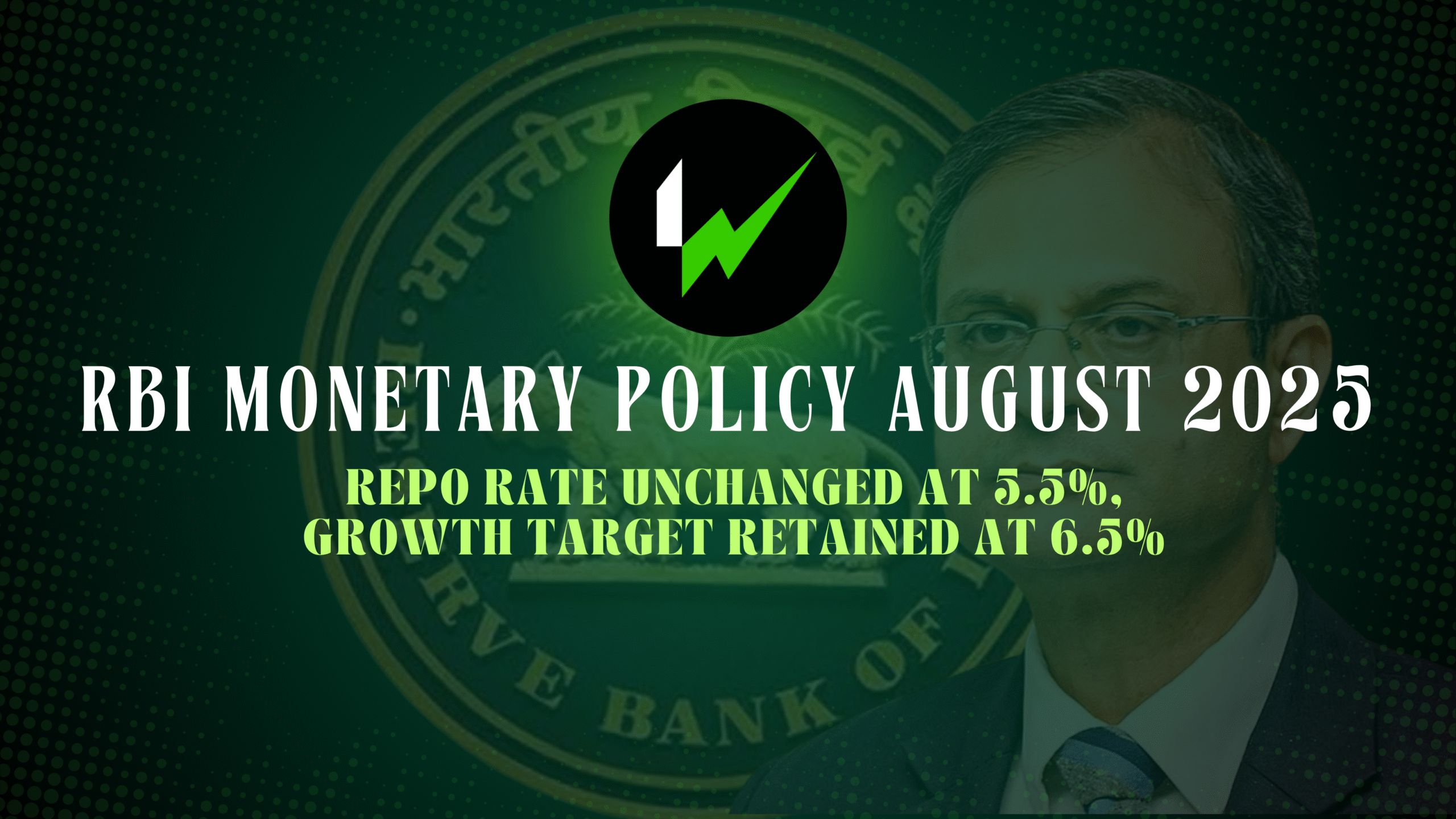RBI Monetary Policy August 2025: Repo Rate Unchanged at 5.5%, Growth Target Retained at 6.5%.
The Reserve Bank of India (RBI) kept the repo rate unchanged at 5.5% during its Monetary Policy Committee (MPC) meeting held from August 4 to August 6, 2025. RBI Governor Sanjay Malhotra announced that the central bank will maintain its ‘neutral’ policy stance, balancing between global uncertainties and domestic economic momentum.
Key Highlights of the RBI Policy Meet:
🔹 Repo Rate Stays at 5.5%
Despite a cumulative 100 basis points (bps) cut since February 2025, the RBI chose to hit pause this time. Governor Malhotra noted that while inflation is cooling, the central bank will adopt a “wait and watch” approach to assess the impact of previous rate cuts.
🔹 GDP Growth Forecast for FY26 Retained at 6.5%
The central bank remains optimistic about India’s economic growth, keeping the GDP growth forecast steady at 6.5% for FY26. However, risks from global trade tensions and geopolitical factors are being closely monitored.
🔹 CPI Inflation Forecast Cut to 3.1% for FY26
RBI sharply lowered its inflation forecast from 3.7% to 3.1%, citing declining commodity prices and a well-progressing monsoon. Notably, June CPI inflation dropped to a 77-month low of 2.1%.
3 Major Consumer-Centric Announcements
1️⃣ Jan Dhan Re-KYC Camps
Banks will hold re-KYC camps at the Panchayat level from July to September, aiming to improve financial inclusion and resolve customer grievances.
2️⃣ Standardized Claim Settlement for Deceased Accounts
RBI will streamline and simplify documentation for claim settlements in cases of deceased customers’ accounts and lockers.
3️⃣ Auto-Bidding for Treasury Bills in Retail Direct Portal
Retail investors can now automate their T-Bill investments via the RBI Retail Direct portal, encouraging wider participation in government securities.
Impact on Real Estate Sector
Real estate developers welcomed the RBI’s decision, as stable borrowing costs are expected to support home loan demand, especially in the affordable and premium housing segments. Industry experts, however, are hoping for a rate cut in upcoming reviews to further drive sectoral growth.
Transmission of Rate Cuts Remains Slow
Of the 100 bps repo rate cut since February, only 55 bps has been transmitted to borrowers. The RBI stressed the need for faster transmission to boost credit growth and consumption.
What Lies Ahead?
The RBI’s neutral stance provides flexibility, allowing the central bank to adjust interest rates based on evolving economic data. With global trade tensions escalating and foreign fund outflows continuing, the RBI’s cautious optimism is aimed at ensuring macroeconomic stability.
Quick Recap
- ✔️ Repo Rate: 5.5% (Unchanged)
- ✔️ GDP Growth FY26: 6.5%
- ✔️ CPI Inflation FY26: 3.1%
- ✔️ Neutral Policy Stance
- ✔️ Focus on Transmission & Financial Inclusion
How Will This Impact the Stock Market?
The RBI’s decision to keep rates steady was widely anticipated, but the market’s reaction will now depend on sector-specific cues and global triggers.
Here’s how different segments could react:
🔹 Banking & NBFCs:
With no further rate cut, banks and NBFCs might see limited margin expansion in the near term. However, the RBI’s push for faster transmission of past rate cuts is positive for loan growth and credit demand, especially in retail loans (home loans, auto loans).
🔹 Real Estate & Housing Finance:
Stable EMIs are a relief for homebuyers, which could maintain momentum in housing demand. Affordable housing stocks and housing finance companies (HFCs) could see a near-term sentiment boost.
🔹 Auto Sector:
Lower inflation and stable interest rates are good news for consumer discretionary stocks like autos. Festive season demand could get a further push if financing remains easy and affordable.
🔹 FMCG & Consumer Stocks:
A softer inflation outlook supports consumer spending, benefiting FMCG companies. However, rural demand still needs to be monitored closely.
🔹 Export-Heavy Sectors (IT, Pharma, Metals):
Export-oriented sectors could face volatility due to global trade tensions and rupee fluctuations. Investors should watch how the India-US trade talks progress.
🔹 Stock Market Outlook:
Nifty and Sensex may stay range-bound in the short term, as investors digest macro cues. Support is seen near 24,400 on Nifty, while 25,000 remains a resistance zone. FIIs are likely to remain cautious till clarity emerges on global tariffs and US Fed’s policy stance.
For investors, it’s a stock-specific and sector rotation market. While broader indices might consolidate, opportunities will emerge in housing, FMCG, and select financials.
Stay tuned with WynWealth for all LIVE stock market & policy updates that actually impact your investments. #WynYourWealth



